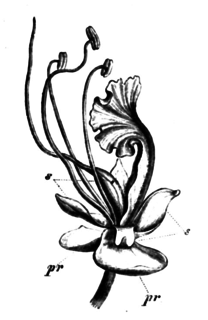Pittier's crab-eating rat is a species of semiaquatic rodent in the family Cricetidae. It is endemic to Venezuela. The natural habitats of this species are rivers and swamps. Its karyotype has 2n = 92 and FNa = 98. This was previously thought to be the highest chromosome number known for a mammal, but it has since been found that the plains viscacha rat or red viscacha rat has 4x = 2n = 102.
Macrolobium amplexans is a species of plant in the family Fabaceae. It is found in Suriname.

Macrolobium is a legume genus in the subfamily Detarioideae. It is a tropical genus with about 80 species. Half occur in Brazil, where they are common in the floodplains of the Amazonian Basin. Members of the genus are used as ornamentals and for their wood.
Macrolobium stenopetalum is a species of plant in the family Fabaceae. It is found in Suriname.
Macrolobium taylorii is a species of plant in the family Fabaceae. It is found only in Peru.
Eschweilera pittieri is a species of woody plant in the Lecythidaceae family. It is found in Colombia, Ecuador, and Panama.
Allobates pittieri is a species of frog in the family Aromobatidae. It is endemic to northern Venezuela where it is known from the Venezuelan Coastal Range and northeastern part of the Cordillera de Mérida. Its type locality is in the Henri Pittier National Park. The species is found in humid lowland to lower montane forest, usually very near rivers and streams where it breeds.

Licania is a genus of over 200 species of trees and shrubs in the family Chrysobalanaceae. Species are found naturally occurring in Neotropical forests from southern Mexico to Brazil and the Lesser Antilles. Due to increased deforestation and loss of habitat, several species have declined, some markedly so, and L. caldasiana from Colombia appears to have gone extinct in recent years. Many species are either rare or restricted in distribution and therefore potentially threatened with future extinction.

Helicia is a genus of 110 species of trees and shrubs, constituting part of the plant family Proteaceae. They grow naturally in rainforests throughout tropical South and Southeast Asia, including India, Sri Lanka, Indochina, Peninsular Malaysia to New Guinea and as far south as New South Wales.
Helicia albiflora is a species of plant in the family Proteaceae. It is endemic to Papua New Guinea. It is threatened by habitat loss.
Helicia amplifolia is a species of plant in the family Proteaceae. It is endemic to Papua New Guinea. It is threatened by habitat loss.
Helicia insularis is a species of plant in the family Proteaceae. It is endemic to Papua New Guinea. It is threatened by habitat loss.
Helicia peltata is a species of plant in the family Proteaceae. It is endemic to Papua New Guinea. It is threatened by habitat loss.
Helicia subcordata is a species of plant in the family Proteaceae. It is endemic to Papua New Guinea. It is threatened by habitat loss.
Heliciopsis lanceolata is a species of plant in the family Proteaceae. It is found in Indonesia and Malaysia. It is threatened by habitat loss.
Heliciopsis rufidula is a species of plant in the family Proteaceae. It is a tree found in Peninsular Malaysia and Borneo. It is threatened by habitat loss.
Protium pittieri is a species of plant in the Burseraceae family. It is found in Costa Rica and Panama. It is threatened by habitat loss.
Tocoyena pittieri is a species of plant in the family Rubiaceae. It is found in Colombia, Costa Rica, Honduras, and Panama.
Trichilia pittieri is a species of plant in the family Meliaceae. It is endemic to Costa Rica.
Annona pittieri is a species of plant in the family Annonaceae. It is native to Costa Rica and Panamá. John Donnell Smith, the American taxonomist who first formally described the species, named it after Henri François Pittier, the Swiss botanist who collected specimen he examined.



